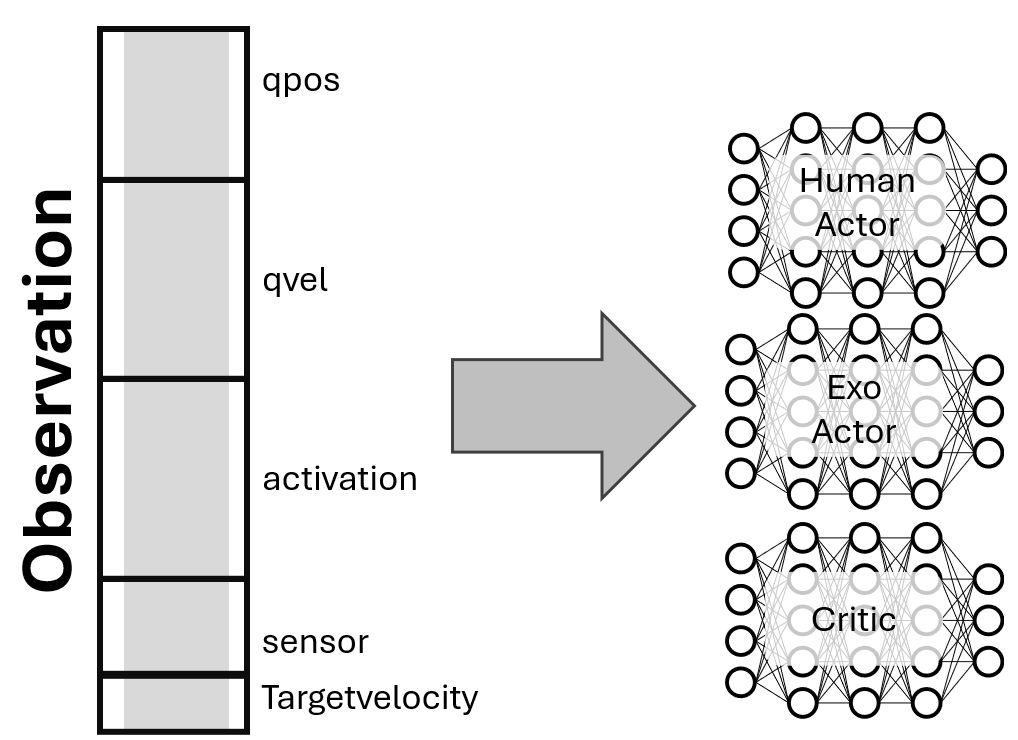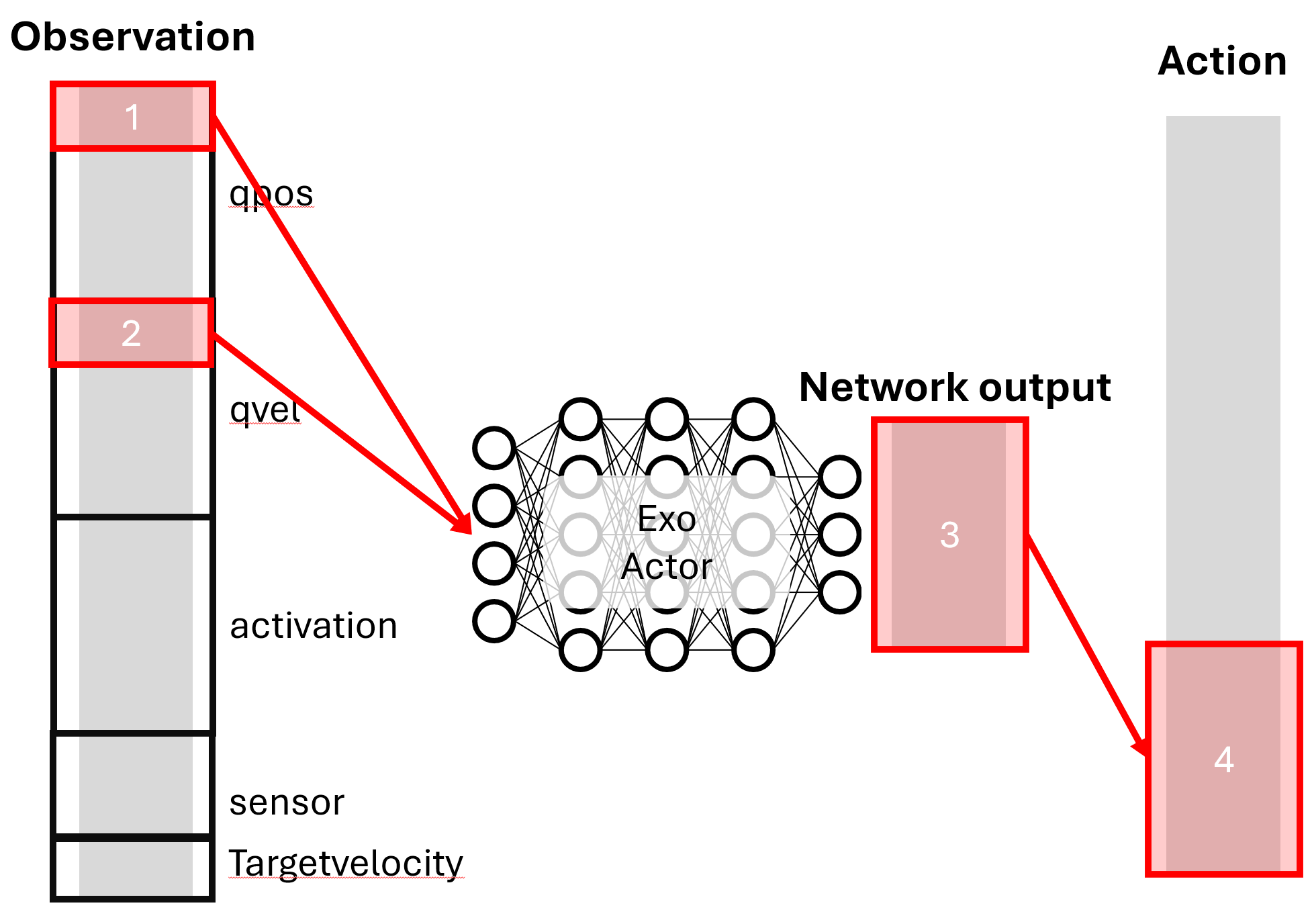Network Index Handler
The Network Index Handler enables selective observation input and targeted action output mapping for different networks in multi-actor reinforcement learning systems. This system allows specific networks to receive only relevant parts of the full observation and maps their outputs to specific indices in the action space.
Overview
Network Indexing is essential when working with:
- Selective Observation Input: Networks that need only specific parts of the full observation
- Targeted Action Mapping: Networks whose outputs should be mapped to specific action indices
- Multi-Actor Coordination: Different actors controlling different parts of the action space

Note:
The order of the observation vector can be checked in theDEFAULT_OBS_KEYSof the gym environment.(rl_train/envs/) Within this, the order ofqpos(joint position),qvel(joint velocity), and joint/sensor keys can be found in the configuration file (e.g.,observation_joint_pos_keys,observation_joint_vel_keys,observation_sensor_keys).
Each observation component is concatenated, so you can determine the index of each element in the full observation vector.
The number of activations corresponds to the number of muscles.
Core Concepts
Observation Indexing
Purpose: Extract specific observation ranges for individual networks
When to Use:
- Different networks require different observation components
- Reducing input complexity for specialized networks
- Sharing observation data efficiently between networks
Example:
{
"type": "range",
"range": [0, 8],
"comment": "Extract joint position data for this network"
}
Action Mapping
Purpose: Map network outputs to specific action space indices
When to Use:
- Network controls only specific action components
- Multiple networks contribute to different parts of the action space
- Coordinating human and exoskeleton actions
Example:
{
"type": "range_mapping",
"range_net": [0, 11],
"range_action": [0, 11],
"comment": "Map network output to right leg muscle actions"
}
Multi-Actor Architecture
Human Actor Network
Purpose: Controls human muscle activations
Observation:
- Receives comprehensive state information
- Processes full observation for coordinated muscle control
Action:
- Outputs muscle activation commands
- Maps to muscle action indices in the action space
Exo Actor Network
Purpose: Controls exoskeleton assistance
Observation:
- Receives only essential information (e.g., ankle data)
- Uses minimal observation for focused control
Action:
- Outputs exoskeleton assistance commands
- Maps to exoskeleton action indices in the action space
Common Critic Network
Purpose: Evaluates overall system performance
Observation:
- Receives full state information
- Evaluates complete system state
Action:
- No action output (critic only)
- Focuses on state evaluation
Configuration Structure
The network indexing configuration follows this structure:
"net_indexing_info": {
"human_actor": {
"observation": [...],
"action": [...]
},
"exo_actor": {
"observation": [...],
"action": [...]
},
"common_critic": {
"observation": [...]
}
}
Actor Networks
Actor networks require both observation and action indexing because they map observations to actions. Each actor network outputs actions based on its own observation subset.
Example Actor Configuration:
"human_actor": {
"observation": [
{
"type": "range",
"range": [0, 8],
"comment": "Joint position data"
},
{
"type": "range",
"range": [8, 16],
"comment": "Joint velocity data"
}
],
"action": [
{
"type": "range_mapping",
"range_net": [0, 11],
"range_action": [0, 11],
"comment": "Right leg muscles"
},
{
"type": "range_mapping",
"range_net": [11, 22],
"range_action": [11, 22],
"comment": "Left leg muscles"
}
]
}
Critic Networks
Critic networks only predict a single value (the value function) and do not output actions. Therefore, they require only observation indexing to specify which parts of the state they evaluate.
Example Critic Configuration:
"common_critic": {
"observation": [
{
"type": "range",
"range": [0, 50],
"comment": "Full state evaluation"
}
]
}
Indexing Types
Range Indexing
Type: "range"
Purpose: Extract specific observation ranges from the full state
Use Cases:
- Providing different networks with different observation components
- Reducing input complexity for specialized networks
- Efficient data sharing between networks
Parameters:
range:[start(inclusive), end(exclusive)]- Inclusive range of indices to extractcomment: Description of the extracted data
Example:
{
"type": "range",
"range": [0, 2],
"comment": "Ankle angle data"
}
Range Mapping
Type: "range_mapping"
Purpose: Map network output ranges to specific action space indices
Use Cases:
- Coordinating multiple networks in the action space
- Ensuring each network controls specific action components
- Preventing conflicts between different actors
Parameters:
range_net:[start(inclusive), end(exclusive)]- Network output rangerange_action:[start(inclusive), end(exclusive)]- Action space range to map tocomment: Description of the action mapping
Example:
{
"type": "range_mapping",
"range_net": [0, 2],
"range_action": [22, 24],
"comment": "Exoskeleton left and right actuators"
}
Example
Here’s a complete example of exoskeleton actor indexing:
Configuration File: imitation_tutorial_22_separated_net_partial_obs.json

"exo_actor": {
"observation": [
{
"type": "range",
"range": [0, 2],
"comment": "2 ankle angles in 8 qpos without lumbar_extension"
},
{
"type": "range",
"range": [8, 10],
"comment": "2 ankle angular velocities in 9 qvel without lumbar_extension"
}
],
"action": [
{
"type": "range_mapping",
"range_net": [0, 2],
"range_action": [22, 24],
"comment": "2 actuators for exoskeleton left and right"
}
]
}